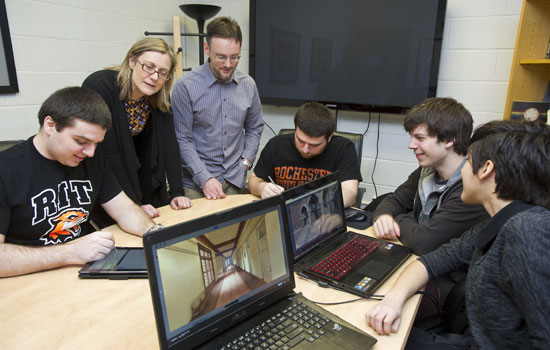Take virtual tour of The Buffalo State Asylum
Imagine RIT exhibit gives visitors a 3D-look inside 19th-century mental illness
A. Sue Weisler
RIT faculty members Lisa Hermsen, second from left, and Shaun Foster, center, work with 3D Digital Design students to develop their interactive Imagine RIT exhibit, “3D Preservation of The Buffalo State Asylum.”
Insane asylums traditionally evoke mental images of stark white hospital rooms, dank hallways, and patients either aimlessly wandering in vegetative states or wildly acting out like Jack Nicholson in One Flew Over the Cuckoo’s Nest.
“3D Preservation of The Buffalo State Asylum,” an exhibit debuting at Imagine RIT: Innovation and Creativity Festival on May 3, will open visitors’ minds—and virtual doors—to a New York state asylum that was fully functional in the late 19th century.
According to Lisa Hermsen, associate professor of English in RIT’s College of Liberal Arts, the exhibit—which will be located on the main floor of the Gordon Field House and Activities Center—is a historically accurate and interactive 3D rendering of The Buffalo State Asylum for the Insane, one of New York state’s most important examples of 19th-century asylum architecture. Imagine RIT visitors will witness the architecture thought to be essential to the cure of mentally ill patients prior to 1900—virtually walking down brightly lit hallways; entering unique dining areas and entertainment rooms; and strolling past brilliant outdoor landscapes with a farm, gardens and walkways.
“The re-building of the Buffalo State Asylum in a 3D interactive environment highlights the possibilities for digital heritage, and there is a definite need to provide historical links to the building’s reform-minded past,” Hermsen said. “Few early American asylums remain standing and there are a surprisingly small number of historically accurate images of them, inside or out. Even those asylums that remain have been repurposed or abandoned and left to vandals and ghost hunters. The ruins of this asylum will be repurposed for a boutique hotel. We all agree that this era of mental health reform should not be forgotten.”
The exhibit—a joint venture with the College of Imaging Arts and Sciences including assistant professor Shaun Foster and students Jayson Fitch, Richard Borba, Michael Borba, Nicolas Burkhart and Deanna Giovinazzo—uses technology, digital innovations and quality graphics that create immersive and interactive heritage preservation, far superior than that of traditional text, pictures or videos. Hermsen also said the exhibit provides resources for humanities approaches to contemporary mental health reform.
“We hope to provide another path to perennial questions about mental health reform, past and present,” Hermsen added. “Indeed, given contemporary discussions about mental health reform, it is even more crucial to get students and scholars to understand reform in the 19th century. This exhibit is a creative and beautiful way to shed light on this important subject.”

